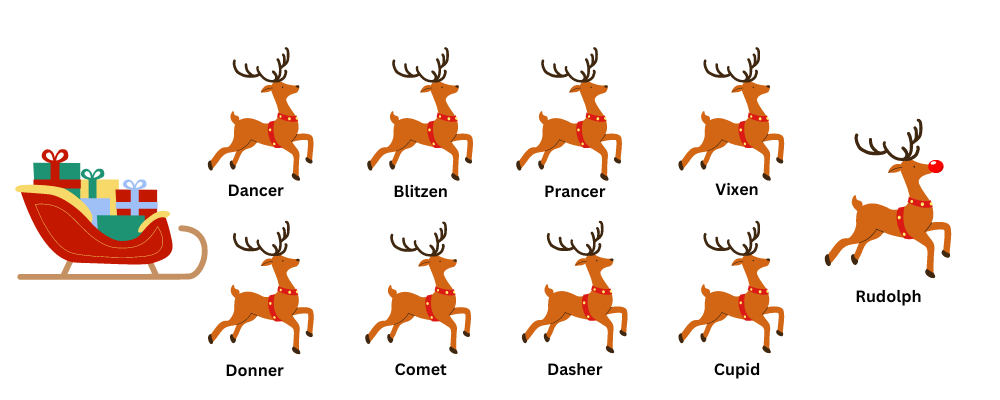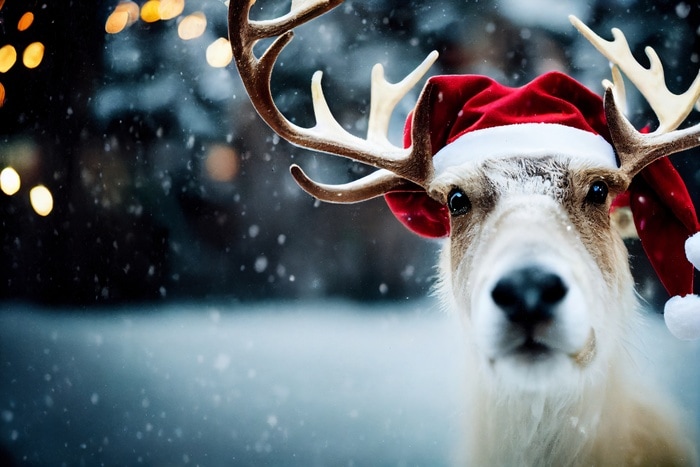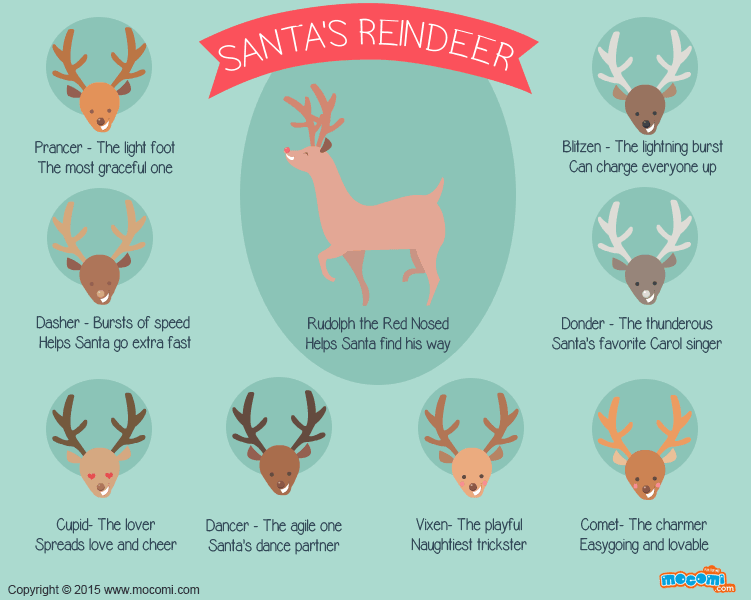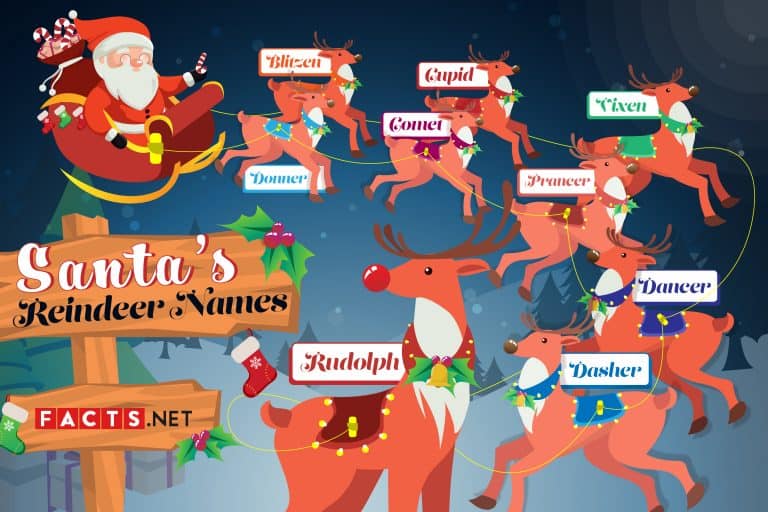A Deep Dive into the Names of Christmas Reindeer: From Folklore to Modern Tradition
Related Articles: A Deep Dive into the Names of Christmas Reindeer: From Folklore to Modern Tradition
Introduction
With great pleasure, we will explore the intriguing topic related to A Deep Dive into the Names of Christmas Reindeer: From Folklore to Modern Tradition. Let’s weave interesting information and offer fresh perspectives to the readers.
Table of Content
A Deep Dive into the Names of Christmas Reindeer: From Folklore to Modern Tradition

The iconic image of Santa Claus’ sleigh pulled by flying reindeer is deeply ingrained in the Christmas narrative. This festive tradition, spanning centuries, extends beyond the visual to encompass the names bestowed upon these mythical creatures. These names, far from being mere whimsy, offer a glimpse into the evolution of Christmas folklore, cultural influences, and the enduring power of storytelling.
Origins and Evolution of Reindeer Names
The earliest mention of Santa’s reindeer, in Clement C. Moore’s 1823 poem "A Visit from St. Nicholas" (more commonly known as "Twas the Night Before Christmas"), only names four: "Dunder," "Blixem," "Dasher," and "Dancer." These names, likely derived from Dutch words, suggest a connection to the Dutch origins of Sinterklaas, the figure who inspired Santa Claus. "Dunder" and "Blixem" translate roughly to "thunder" and "lightning," respectively, reflecting the power and speed associated with the reindeer.
However, it was the 1939 Coca-Cola advertisement featuring a jolly, red-suited Santa and his reindeer that cemented the now-familiar image and solidified the reindeer’s names. This advertisement, created by Haddon Sundblom, introduced the remaining reindeer: "Prancer," "Vixen," "Comet," "Cupid," and "Rudolph." These names, with their more whimsical and playful nature, reflect a shift in the portrayal of Santa and his reindeer, emphasizing their joyful and magical aspects.
The Significance of Reindeer Names
The names given to Santa’s reindeer serve several purposes:
- Personification: By assigning names, the reindeer become more than mere beasts of burden. They acquire individual personalities and traits, making them relatable and engaging for children.
- Storytelling and Imagination: The names, often evocative of their character or abilities, enhance the storytelling aspect of the Christmas narrative. "Dasher" and "Dancer" suggest speed and agility, while "Comet" and "Cupid" evoke celestial imagery and love.
- Cultural Influence: The names, some reflecting Dutch origins, others rooted in English language and culture, highlight the diverse influences that have shaped the Christmas tradition.
- Enduring Symbolism: The reindeer names, particularly "Rudolph," have become iconic symbols of Christmas, transcending cultural boundaries and representing joy, generosity, and the spirit of the holiday.
The Role of Rudolph
Rudolph, with his bright red nose, stands out among Santa’s reindeer. His name, derived from the German word "Rudolf," meaning "famous wolf," initially held no special significance. However, his distinctive feature, introduced in Robert L. May’s 1939 story "Rudolph the Red-Nosed Reindeer," transformed him into a symbol of acceptance and individuality. Rudolph’s story, about overcoming challenges and finding strength in his unique trait, resonates with children and adults alike, making him a beloved character.
Modern Interpretations and Adaptations
In recent years, the names of Santa’s reindeer have been adapted and reinterpreted in various forms of media, from children’s books and television shows to movies and video games. These adaptations often introduce new elements to the reindeer’s personalities and backstories, further enriching their characters and enhancing their appeal.
FAQs about Christmas Reindeer Names
Q: What is the origin of the reindeer names?
A: The names of Santa’s reindeer have various origins, including Dutch, English, and German influences. Some names, like "Dasher" and "Dancer," were likely chosen for their evocative qualities, while others, like "Rudolph," have more complex origins and symbolism.
Q: Why are there so many different names for Santa’s reindeer?
A: The increasing number of reindeer names reflects the evolution of the Christmas tradition and the desire to create a more engaging and memorable story. Each name adds to the reindeer’s individual personalities and strengthens the connection between the audience and these mythical creatures.
Q: What is the significance of Rudolph’s name?
A: Rudolph’s name, derived from the German word "Rudolf," meaning "famous wolf," initially held no special significance. However, his red nose, which became a symbol of acceptance and individuality, made his name synonymous with his unique characteristic.
Q: Have the reindeer names changed over time?
A: While the core group of reindeer names has remained relatively consistent, there have been variations and adaptations in different versions of the Christmas story. For instance, some versions include additional reindeer or modify the original names.
Tips for Using Christmas Reindeer Names
- Consider the context: The reindeer names can be used in various contexts, from children’s literature and festive decorations to branding and marketing campaigns. It is crucial to choose names that align with the specific purpose and target audience.
- Embrace creativity: The reindeer names offer a starting point for creative exploration. They can be used as inspiration for character development, plot points, or even product names.
- Respect tradition: While adaptations and re-interpretations are encouraged, it is important to acknowledge the significance of the original reindeer names and their role in shaping the Christmas tradition.
Conclusion
The names of Santa’s reindeer are more than just whimsical labels. They represent a rich tapestry of folklore, cultural influences, and storytelling traditions. From their origins in Dutch folklore to their modern adaptations, the reindeer names continue to inspire imagination and capture the spirit of Christmas. As we celebrate the holiday season, let us appreciate the magic and enduring power of these iconic names and the stories they tell.


/santa-reindeer-56a9a2995f9b58b7d0fd8fd0.jpg)





Closure
Thus, we hope this article has provided valuable insights into A Deep Dive into the Names of Christmas Reindeer: From Folklore to Modern Tradition. We appreciate your attention to our article. See you in our next article!